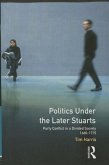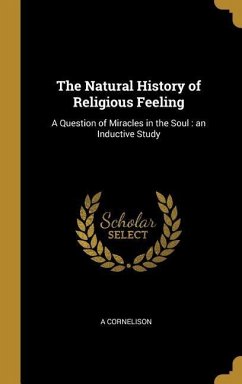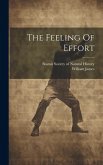Feeling Exclusion
Religious Conflict, Exile and Emotions in Early Modern Europe
Herausgeber: Tarantino, Giovanni; Zika, Charles
Feeling Exclusion
Religious Conflict, Exile and Emotions in Early Modern Europe
Herausgeber: Tarantino, Giovanni; Zika, Charles
- Gebundenes Buch
- Merkliste
- Auf die Merkliste
- Bewerten Bewerten
- Teilen
- Produkt teilen
- Produkterinnerung
- Produkterinnerung
Feeling Exclusion investigates the emotional experience of exclusion at the heart of the religious life of persecuted and exiled individuals and communities in early modern Europe. It is perfect for students and researchers of early modern emotions and religion.
Andere Kunden interessierten sich auch für
![Politics under the Later Stuarts Politics under the Later Stuarts]() Tim HarrisPolitics under the Later Stuarts220,99 €
Tim HarrisPolitics under the Later Stuarts220,99 €![Imperial History and the Global Politics of Exclusion Imperial History and the Global Politics of Exclusion]() Amanda BehmImperial History and the Global Politics of Exclusion93,99 €
Amanda BehmImperial History and the Global Politics of Exclusion93,99 €![The Stranger: Or, The New Man of Feeling The Stranger: Or, The New Man of Feeling]() J. CThe Stranger: Or, The New Man of Feeling34,99 €
J. CThe Stranger: Or, The New Man of Feeling34,99 €![Reasons for Feeling Secure in the Church of England: A Letter to A Friend, in Answer to Doubts Expr Reasons for Feeling Secure in the Church of England: A Letter to A Friend, in Answer to Doubts Expr]() Monro Edward AReasons for Feeling Secure in the Church of England: A Letter to A Friend, in Answer to Doubts Expr29,99 €
Monro Edward AReasons for Feeling Secure in the Church of England: A Letter to A Friend, in Answer to Doubts Expr29,99 €![The Natural History of Religious Feeling The Natural History of Religious Feeling]() A. CornelisonThe Natural History of Religious Feeling36,99 €
A. CornelisonThe Natural History of Religious Feeling36,99 €![The Feeling Of Effort The Feeling Of Effort]() William JamesThe Feeling Of Effort29,99 €
William JamesThe Feeling Of Effort29,99 €![The use and Abuse of Party-feeling in Matters of Religion, Considered in Eight Sermons Preached Before the University of Oxford, in the Year 1822, at The use and Abuse of Party-feeling in Matters of Religion, Considered in Eight Sermons Preached Before the University of Oxford, in the Year 1822, at]() Richard WhatelyThe use and Abuse of Party-feeling in Matters of Religion, Considered in Eight Sermons Preached Before the University of Oxford, in the Year 1822, at38,99 €
Richard WhatelyThe use and Abuse of Party-feeling in Matters of Religion, Considered in Eight Sermons Preached Before the University of Oxford, in the Year 1822, at38,99 €-
-
-
Feeling Exclusion investigates the emotional experience of exclusion at the heart of the religious life of persecuted and exiled individuals and communities in early modern Europe. It is perfect for students and researchers of early modern emotions and religion.
Hinweis: Dieser Artikel kann nur an eine deutsche Lieferadresse ausgeliefert werden.
Hinweis: Dieser Artikel kann nur an eine deutsche Lieferadresse ausgeliefert werden.
Produktdetails
- Produktdetails
- Verlag: Routledge
- Seitenzahl: 312
- Erscheinungstermin: 29. Oktober 2019
- Englisch
- Abmessung: 240mm x 161mm x 21mm
- Gewicht: 634g
- ISBN-13: 9781138219175
- ISBN-10: 1138219177
- Artikelnr.: 58057365
- Herstellerkennzeichnung
- Libri GmbH
- Europaallee 1
- 36244 Bad Hersfeld
- gpsr@libri.de
- Verlag: Routledge
- Seitenzahl: 312
- Erscheinungstermin: 29. Oktober 2019
- Englisch
- Abmessung: 240mm x 161mm x 21mm
- Gewicht: 634g
- ISBN-13: 9781138219175
- ISBN-10: 1138219177
- Artikelnr.: 58057365
- Herstellerkennzeichnung
- Libri GmbH
- Europaallee 1
- 36244 Bad Hersfeld
- gpsr@libri.de
Giovanni Tarantino is Research Lecturer in Early Modern History at the University of Florence and Chair of the COST Action 'People in Motion (1492-1923)'. His publications include Republicanism, Sinophilia and Historical Writing: Thomas Gordon (c.1691-1750) and his History of England (2012) and Lo scrittoio di Anthony Collins (1676-1729) (2007). Charles Zika is a Professorial Fellow in History at the University of Melbourne. His interests lie in the intersections of religion, emotion, visual culture, and print in early modern Europe, and his publications include The Appearance of Witchcraft: Print and Visual Culture in Sixteenth-Century Europe (2007).
Part 1: Belonging and Displacement, Chapter 1: Emotion, Exclusion, Exile:
The Huguenot Experience during the French Religious Wars; Chapter 2:
Cross-Channel Affections: Pressure and Persuasion in Letters to Calvinist
Refugees in England, 1569-1570; Chapter 3: A Tearful Diaspora: Preaching
Religious Emotions in the Huguenot Refuge; Chapter 4: Between Hope and
Despair: Epistolary Evidence of the Emotional Effects of Persecution and
Exile during the Thirty Years War; Part 2 Coping with Persecution and Exile
, Chapter 5: The Embodiment of Exile: Relics and Suffering in Early Modern
English Cloisters; Chapter 6: Fear and Loathing in the Radical Reformation:
David Joris as the Prophet of Emotional Tranquillity, 1525-1556; Chapter 7:
'I am contented to die': The Letters from Prison of the Waldensian
Sebastian Bazan (d. 1623) and the Anti-Jacobite Narratives of the Reformed
Martyrs of Piedmont, Chapter 8: Seventeenth-Century Quakers, Emotions and
Egalitarianism: Sufferings, Oppression, Intolerance and Slavery; Chapter 9:
She Suffered for Christ Jesus' Sake: The Scottish Covenanters' Emotional
Strategies to Combat Religious Persecution (1685-1714); Part 3: "Othering"
Strategies, Chapter 10: Feeling Jewish: Emotions, Identity, and the Jews'
Inverted Christmas; Chapter 11: Towards an Alien Community of Dancing
Witches in Early Seventeenth-Century Europe; Chapter 12: Visual
Provocations: Bernard Picart's Illustrative Strategies in Cérémonies et
coutumes religieuses de tous les peuples du monde; Chapter 13: Feeling
Upside Down: Witchcraft and Exclusion in the Twilight of Early Modern
Spain; Afterword: Emotional Communities and the Early Modern Religious
Exile Experience
The Huguenot Experience during the French Religious Wars; Chapter 2:
Cross-Channel Affections: Pressure and Persuasion in Letters to Calvinist
Refugees in England, 1569-1570; Chapter 3: A Tearful Diaspora: Preaching
Religious Emotions in the Huguenot Refuge; Chapter 4: Between Hope and
Despair: Epistolary Evidence of the Emotional Effects of Persecution and
Exile during the Thirty Years War; Part 2 Coping with Persecution and Exile
, Chapter 5: The Embodiment of Exile: Relics and Suffering in Early Modern
English Cloisters; Chapter 6: Fear and Loathing in the Radical Reformation:
David Joris as the Prophet of Emotional Tranquillity, 1525-1556; Chapter 7:
'I am contented to die': The Letters from Prison of the Waldensian
Sebastian Bazan (d. 1623) and the Anti-Jacobite Narratives of the Reformed
Martyrs of Piedmont, Chapter 8: Seventeenth-Century Quakers, Emotions and
Egalitarianism: Sufferings, Oppression, Intolerance and Slavery; Chapter 9:
She Suffered for Christ Jesus' Sake: The Scottish Covenanters' Emotional
Strategies to Combat Religious Persecution (1685-1714); Part 3: "Othering"
Strategies, Chapter 10: Feeling Jewish: Emotions, Identity, and the Jews'
Inverted Christmas; Chapter 11: Towards an Alien Community of Dancing
Witches in Early Seventeenth-Century Europe; Chapter 12: Visual
Provocations: Bernard Picart's Illustrative Strategies in Cérémonies et
coutumes religieuses de tous les peuples du monde; Chapter 13: Feeling
Upside Down: Witchcraft and Exclusion in the Twilight of Early Modern
Spain; Afterword: Emotional Communities and the Early Modern Religious
Exile Experience
Part 1: Belonging and Displacement, Chapter 1: Emotion, Exclusion, Exile:
The Huguenot Experience during the French Religious Wars; Chapter 2:
Cross-Channel Affections: Pressure and Persuasion in Letters to Calvinist
Refugees in England, 1569-1570; Chapter 3: A Tearful Diaspora: Preaching
Religious Emotions in the Huguenot Refuge; Chapter 4: Between Hope and
Despair: Epistolary Evidence of the Emotional Effects of Persecution and
Exile during the Thirty Years War; Part 2 Coping with Persecution and Exile
, Chapter 5: The Embodiment of Exile: Relics and Suffering in Early Modern
English Cloisters; Chapter 6: Fear and Loathing in the Radical Reformation:
David Joris as the Prophet of Emotional Tranquillity, 1525-1556; Chapter 7:
'I am contented to die': The Letters from Prison of the Waldensian
Sebastian Bazan (d. 1623) and the Anti-Jacobite Narratives of the Reformed
Martyrs of Piedmont, Chapter 8: Seventeenth-Century Quakers, Emotions and
Egalitarianism: Sufferings, Oppression, Intolerance and Slavery; Chapter 9:
She Suffered for Christ Jesus' Sake: The Scottish Covenanters' Emotional
Strategies to Combat Religious Persecution (1685-1714); Part 3: "Othering"
Strategies, Chapter 10: Feeling Jewish: Emotions, Identity, and the Jews'
Inverted Christmas; Chapter 11: Towards an Alien Community of Dancing
Witches in Early Seventeenth-Century Europe; Chapter 12: Visual
Provocations: Bernard Picart's Illustrative Strategies in Cérémonies et
coutumes religieuses de tous les peuples du monde; Chapter 13: Feeling
Upside Down: Witchcraft and Exclusion in the Twilight of Early Modern
Spain; Afterword: Emotional Communities and the Early Modern Religious
Exile Experience
The Huguenot Experience during the French Religious Wars; Chapter 2:
Cross-Channel Affections: Pressure and Persuasion in Letters to Calvinist
Refugees in England, 1569-1570; Chapter 3: A Tearful Diaspora: Preaching
Religious Emotions in the Huguenot Refuge; Chapter 4: Between Hope and
Despair: Epistolary Evidence of the Emotional Effects of Persecution and
Exile during the Thirty Years War; Part 2 Coping with Persecution and Exile
, Chapter 5: The Embodiment of Exile: Relics and Suffering in Early Modern
English Cloisters; Chapter 6: Fear and Loathing in the Radical Reformation:
David Joris as the Prophet of Emotional Tranquillity, 1525-1556; Chapter 7:
'I am contented to die': The Letters from Prison of the Waldensian
Sebastian Bazan (d. 1623) and the Anti-Jacobite Narratives of the Reformed
Martyrs of Piedmont, Chapter 8: Seventeenth-Century Quakers, Emotions and
Egalitarianism: Sufferings, Oppression, Intolerance and Slavery; Chapter 9:
She Suffered for Christ Jesus' Sake: The Scottish Covenanters' Emotional
Strategies to Combat Religious Persecution (1685-1714); Part 3: "Othering"
Strategies, Chapter 10: Feeling Jewish: Emotions, Identity, and the Jews'
Inverted Christmas; Chapter 11: Towards an Alien Community of Dancing
Witches in Early Seventeenth-Century Europe; Chapter 12: Visual
Provocations: Bernard Picart's Illustrative Strategies in Cérémonies et
coutumes religieuses de tous les peuples du monde; Chapter 13: Feeling
Upside Down: Witchcraft and Exclusion in the Twilight of Early Modern
Spain; Afterword: Emotional Communities and the Early Modern Religious
Exile Experience








